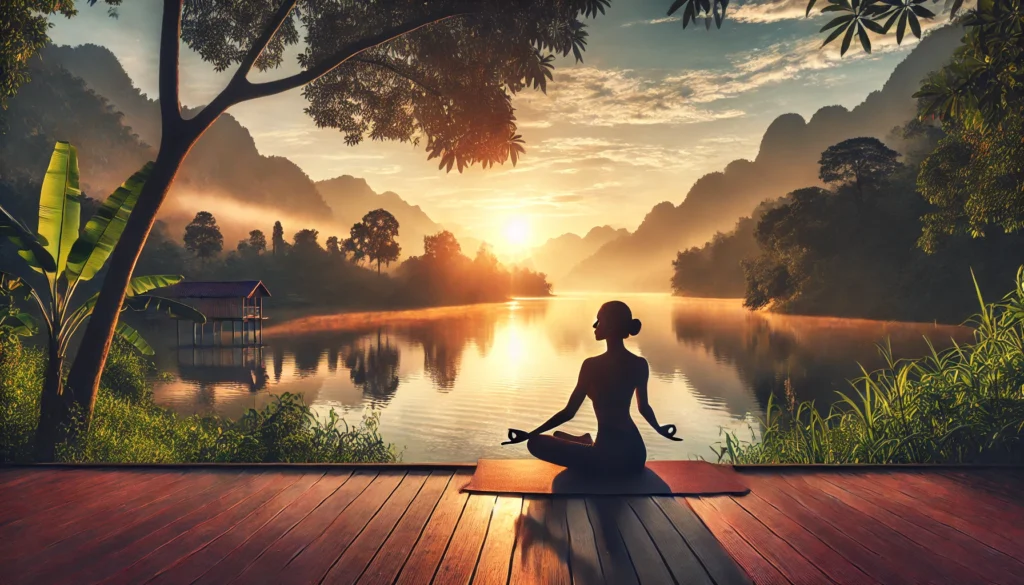Table of Contents
Introduction: finding balance
Life these days just rushes along at a whirlwind pace. With work, relationships, duties, and the steady stream of information, it’s simple to feel in chaos.
We all want to be balanced—either balancing work and personal time, staying mentally acute, or being physically and emotionally fit. But how do we find this balance in a world that never seems to slow down?
Yoga holds the solution. Yoga is not simply a workout; in finding balance it is a practice that integrates the body, mind, and spirit so we can discover harmony in our world.
In utilizing the practice of breath control, awareness, movement, and meditation, yoga sessions provide a dedicated environment in which we are able to slow down, recharge, and connect again with ourselves.
If you’ve ever felt disconnected, exhausted, or overwhelmed, this is your invitation to discover how yoga can guide you back into balance and enhance your sense of well-being.

The Importance of Balance in Life: finding balance
Balance is not putting your foot on one leg or dividing your time precisely half and half between work and play. Balance is being strong, centerstrong, and calm in life. When we are not in balance, we are stressed, burned out, and even sick. But when we are in balance, we are healthier, more content, and in control.
There are a few different kinds of balance:
Physical: Retaining strength, coordination, and mobility so life goes smoothly.
Mental : Regulating thoughts and emotions in manners enhancing understanding and welfare.
Emotional : Resilience when recovering from adversity and stress and not being broken by them.
Spiritual balance: Feeling attached to a larger sense of meaning, a peaceful mind, or a higher sense of knowing one’s self.
The wonderful thing about yoga is that it builds all of these aspects simultaneously. As we practice regularly, yoga helps us tune in to how we feel, finding balance what we need, and how to find balance in our lives.


Yoga: A Path to Physical Balance: finding balance
One of the first things that you will find in a yoga class is that how much it tests your body in a gentle but energetic manner. Contrary to weighty exercises, which strain you to the core, yoga strengthens and flexes you in a conscious, finding balance in deliberate way.
1. Building Flexibility and Strength
We tend to take the value of flexibility and strength for granted in our everyday lives. Whether we bend to lace our shoes, pick up groceries, or sit easily at our desk, flexibility and strength determine the manner in which we move and feel.
Downward Dog, Warrior Poses, and Tree Pose in yoga stretch contracted muscles and strengthen essential areas such as the core, legs, and back.
By doing yoga on a regular basis, you’ll find your body opening and growing stronger, becoming less inflexible and less susceptible to injury.
2. Improving Posture and Alignment
Hunched over a computer or mobile phone all day? Do not worry, you are not alone. Slouching is an epidemic that creates back pain, tension, and discomfort. Yoga focuses on proper alignment, showing you how to stand, sit, and move in ways that are gentle on your spine.
Basic poses such as Mountain Pose and Cobra Pose assist in reeducating posture, reducing tension and increasing natural movement and ease in everyday activity.
3. Improving and finding Balance and Coordination
Balance is not a matter of staying still but rather moving securely and with command. Yoga invigorates the proprioception or your body sense of where you are in relation to space.
Balancing exercises such as Tree Pose and Dancer’s Pose test your steadiness and prepare you to make better coordination in order to prevent falls, as we age.
Also, Vinyasa flow poses help create smooth movement, conditioning the body to flow with grace and coordination. Your muscles and nervous system will eventually connect more forcefully, leading to greater overall body awareness and athletic skill in other sports.


Mental Balance Through Yoga: finding balance
The mind is usually the most difficult to balance. With racing thoughts, mile-long to-do lists, and constant stressors in everyday life, mental clutter keeps one from being present and focused. Yoga silences the mental chatter, bringing clarity and calmness.
1. Reducing Stress and Anxiety: finding balance
Yoga is not just movement; it is also a breathing practice. Conscious breathing exercises such as Pranayama stimulate the parasympathetic nervous system and encourage the body to become calm.
A recent study discovers yoga reduces the body’s level of the stress hormone cortisol, and yoga is a successful means of reducing anxiety and tension.
Next time you’re feeling overwhelmed, try a simple breathing exercise: inhale for four counts, hold for four, and exhale for four. Even a few minutes of conscious breathing can shift your entire state of mind.
2. Improving Focus and Mental Clarity: finding balance
If you’ve ever struggled to concentrate, you know how infuriating it can be. Yoga instructs in mindfulness, training the mind to stay present rather than flitting from distraction to distraction. Poses like Eagle Pose and Warrior III require complete concentration, sharpening your skills at concentrating on and off the mat.
With regular practice, you’ll find that you’re more present, make better decisions, and approach tasks with a clear, centered mind.


Enhancing Emotional and Spiritual Balance:finding balance
Yoga is not merely a body or mind exercise; it’s also an emotional healing and spiritual development. If you believe spirituality is having an association with a divine power or alternatively making peace within yourself, yoga gives the means to build the connection.
1. Developing Emotional Resilience in finding balance
Learning to practice yoga allows us to develop patience and compassion. It shows us how to simply sit with what hurts, be it the pose or feeling, and investigate it with curiosity and not judgment. This tenacity transfers to the rest of life, and making things more difficult to handle.
2. Developing a Morning Routine for Being Present in finding balance
Adding yoga to a daily practice can be a grounding ritual. Whether a morning sun salutation or an evening restorative flow, setting aside a specific time to tune in to yourself creates self-awareness and a sense of grounding in an uncertain world.
3. The Role of Community in Yoga in finding balance
Yoga is not a solo activity—nor is it commonly done in solitude. Going to yoga class produces camaraderie between individuals of similar interests and aspirations to learn and develop.
The encouragement and support received in a yoga center can be highly inspirational, producing a feeling of belonging to something greater than oneself and a need to keep the self-improvement path going.
It brings total wellness, but with the speed and pressure of our current society, balance seems an unattainable dream.
Balance is more than deciding on the most productive way to divide time among work, family, and personal needs; balance means balancing every element of life—body, mind, heart, and soul.
When we’re out of balance, we’re stressed, burned out, and miserable, but when we create it, we’re more centered, fulfilled, and the masters of our own lives.
It does take effort, awareness, and skill at prioritizing what’s most important. It is not perfection but understanding how to balance several aspects of life in a way that preserves our well-being.
One of the most important aspects of achieving balance is taking care of our physical health. Our bodies are the building blocks on which all else is constructed. If we don’t maintain our physical health—by not exercising, by eating badly, or by not sleeping enough—the rest of our lives pay for it.
Regular movement, such as yoga, walking, or any form of physical activity, keeps us healthy, flexible, and full of energy. Yoga, in particular, is a fine tool for achieving balance as it strengthens the physical body while calming the mind.
Rest also comes into play; without adequate sleep, our competence at dealing with daily challenges is diminished. A routine of exercise, healthy eating, and sleeping keeps us physically balanced, hence optimizing our capacity to deal with daily issues.
We also require mental balance. Our mind creates our life, and if our mind is filled with worry, anxiety, and distractions all the time, it’s difficult to concentrate and be present. Mindfulness, meditation, and deep breathing are healthy habits to calm the mind and enhance concentration.
To be in finding balance in the mind is to understand how to manage thoughts, release the negativity, and develop the sense of presence. Breaking, gratitude, and boundary setting with technology can really make a big difference in mental clarity and stress reduction.
One should remember that mental equilibrium is a continuous process—it takes constant self-awareness and intentional behavior to have a peaceful and clear mind.
Emotional equilibrium contributes greatly to the way we manage life issues. Emotional wellness is not being without negative feelings; it is being in touch with, processing, and responding to emotions in a healthy manner.
Being kind to yourself and aware of yourself makes it easier for us to handle tough situations. Emotional balance includes having good relationships, having healthy boundaries, and being stress-free without being overwhelmed.
Expression of feelings through writing them down, discussing with a close friend, or indulging in creative activities can help us stay emotionally balanced. Emotion care strengthens life and keeps it peaceful.
In addition to the physical, mental, and emotional, balance also extends to our spiritual existence. To some, spirituality is about being connected to a god, and to others, simply about having purpose, inner peace, or attachment to the environment.
A small amount of me time of self-reflection, gratitude, and engagement in personally aligned activity provides spiritual balance.
Conclusion
Most feel it gives them that sense of grounding and wholeness with practice like meditation, yoga, or a walk outside. Spiritual balance will allow us to look at life in a wider perspective, be present in the moment, and develop inner peace. Getting balance really is an ongoing process and not a one-time thing.
It takes ongoing self-reflection, adjustment, and conscious decision-making. In a world that never appears to have enough of us, taking the time to make balance our priority allows us to live more mindfully, peacefully, and happily.
Whether as simple daily habits such as mindful breathing or more drastic lifestyle shifts, each step we make toward balance enhances our way of life.
By attending to body, mind, emotions, and spirit, we can create a balanced and happy life—a life in which we’re not merely surviving, but thriving. Conclusion: Back to Yoga for Balance
Balance is not a matter of being perfect; balance is creating an equilibrium between the mind, the body, and the spirit. Yoga offers the path to balancing, giving individuals the tools necessary to strengthen the body, serenize the mind, and feed the soul.
If you want more stability, peace, or clarity in life, try taking a yoga class. You don’t have to have experience or flexibility—just an open mind and a readiness to start. Your journey towards balance begins now.
When you get onto the mat, understand that yoga is a life journey. You are not progressing toward any specific place, just continuous learning, expansion, and discovery of yourself. The more you practice, the more balance will be there, not just in your yoga asana but in your entire life.
